Public opinion about climate and energy issues is strongly divided along political party and ideological lines. This chapter reviews those patterns underlying beliefs about climate change, perceived consensus among scientists about climate change, and views about one policy prescription aimed at reducing climate change. Liberal Democrats are especially inclined to hold the view that the Earth is warming due to human activity, they are more likely to see consensus among scientists about this issue and are more in favor of setting stricter plant emission limits in order to address climate change. These patterns are consistent with Pew Research Center’s and others’ past public surveys, which show a widening gap between political groups in views about climate issues over time.17
Also consistent with past surveys, there are strong party and ideological fissures in public views related to energy issues with conservative Republicans especially likely to support more offshore drilling for oil and gas in U.S. waters, to support increased use of hydraulic fracturing to extract oil and gas from underground, and to support building more nuclear power plants to generate electricity. Other factors that predict views on these issues include gender and age: Men and older adults express more support of these energy technologies, on average, than do women or younger adults, respectively. There is one exception; a majority of all major demographic and political groups support the increased use of genetically engineered plants as a fuel alternative to gasoline.
Beliefs about the likely effect of global population growth as it relates to natural resources also are divided along political lines. Here, too, liberal Democrats tend to see the growing world population as a likely strain on food supply and natural resources, while conservative Republicans are more inclined to believe that new ways to stretch our resources will keep the growing world population from being a major problem.
Climate Change Opinions

The survey included two separate measures to gauge public attitudes about climate change. When asked to pick among three choices, 50% of adults say that climate change is occurring mostly because of human activity, such as burning fossil fuels; 23% say that climate change is mostly because of natural patterns in the Earth’s environment; and another 25% say there is no solid evidence the Earth is getting warmer. The share of the public saying climate change is due to human activity is about the same as it was in 2009 when Pew Research Center last asked this question, but more now say there is no solid evidence of warming (25% today, up from 11% in 2009) and fewer say that warming is occurring due to natural patterns in the environment (23% today, down from 36% in 2009).

In a separate series of questions, adults in the general public were asked, first, whether or not there is solid evidence that the average temperature of the Earth has been getting warmer over the past few decades. Fully 72% of adults say there is solid evidence of warming, while a quarter (25%) say there is no solid evidence of this.
Follow-up questions find that most of those who believe the Earth is warming think warming is due to human activity (46% of all adults), rather than natural patterns in the Earth’s environment (22% of all adults). Those who say there is no solid evidence the Earth is getting warmer are split between those who say the evidence is not yet clear (11% of all adults) and that warming is not occurring (13% of all adults).18

We show differences among subgroups using just one measure of views about climate change below. These patterns are roughly the same regardless of which measures are used.19 We combine responses from either approach in the multivariate analysis of factors influencing opinion about climate change.
Gender, Age, Race and Ethnicity
Consistent with past surveys, there are wide differences by age in views about climate change, with adults ages 65 and older more skeptical than younger age groups that there is solid evidence the Earth is warming.
Hispanics are more inclined than non-Hispanic whites to say the Earth is warming due to human activity.20
Men and women hold similar views about climate change on this question. However, when a randomly selected half of the sample was asked first whether there is solid evidence the Earth is warming, women were more likely than men to say this was the case (79% compared with 63%). This gender difference is consistent with past Pew Research Center surveys.
Education and Knowledge

Those with a college degree are more likely than those with less education to say that climate change is occurring due to human activity. Among all those with a college degree 56% say that warming is due to human activity. By comparison, 44% of those with a high school degree or less schooling say the same.
Views about climate change are roughly the same regardless of level of science knowledge. There are no differences in views between those with a degree in a scientific field and those with training in other fields.
Party and Ideology

Views about climate change differ substantially among party and political ideological groups, as also was the case in past surveys. The size of the differences between partisans on climate change has grown since 2006, when Pew Research first began tracking public opinion on this topic.
Fully 71% of Democrats and independents who lean Democratic say the Earth is warming primarily due to human activity. By contrast, only 27% of Republicans and those who lean Republican hold this view; 30% say climate change is mostly due to natural patterns in the Earth’s environment and 41% say there is no solid evidence the Earth is warming.21
Fully 76% of liberals say the Earth is warming due to human activity. By contrast, 29% of conservatives say the human activity is the reason for climate change; three-in-ten say that natural processes account for climate change and 39% say there is no solid evidence the Earth is warming. Moderates’ views on climate change fall somewhere in between these two groups.
A 57% majority of conservative Republicans says there is no solid evidence the Earth is warming; just one-in-ten says that human activity accounts for climate change. By contrast, 78% of liberal Democrats say that human activity accounts for climate change.
Past Pew Research surveys also have shown more skepticism among Tea Party Republicans that the Earth is warming. Among Democrats, there are substantial differences by education, with those holding a college degree more likely than those with less schooling to say the Earth is warming due to human activity.22
Multivariate Analyses
To better understand the relative influence of these factors on views about climate change we conducted a series of multivariate regression analyses. In order to maximize the sample size available for this analysis, responses from the two ways of measuring climate change were combined. Those who were unsure whether climate change is occurring or the processes that account for climate change were omitted from this analysis. We tested a series of models including the one shown here, which includes belief about scientific consensus on climate change as an explanatory factor in respondent’s beliefs about climate change. (For more on perceptions of scientific consensus and other judgments related to climate change, see below.)23
We turn, first, to predicting the view that climate change is occurring (whether due to human or natural processes) as compared with the view that there is no solid evidence of warming.24 A person who says that scientists generally agree that human activity is causing global warming has a predicted probability of saying that the Earth is warming of 0.87 on a scale of 0 to 1, or 87%. A person who says that scientists generally do not agree about this has a predicted probability of saying that the Earth is warming of 0.70 (70%) − a difference of 0.17 (or 17 percentage points). Women (+0.08) are more likely than men and Hispanics (+0.10) are more likely than non-Hispanic whites to say the Earth is warming.
Political party and ideology are also strong predictors. Republicans and those who lean Republican are 20 percentage points less likely than Democrats and those who lean Democratic to say the Earth is warming. Those with no party affiliation or lean are less likely (-0.14) than are Democrats (including independents who lean to the Democratic Party) to say the Earth is warming. Ideology also has an independent effect on views with conservatives less likely than liberals (-0.16) to say the Earth is warming. Individuals who describe their ideology as liberal and identify as Democrat or leaning Democratic have a predicted probability of 0.76, while those who are conservative and Republican or leaning Republican have a predicted probability of 0.22 of saying the Earth is warming due to human activity, holding all other factors at their means.

Next, we show the results of a logistic regression predicting the view that the Earth is warming due to human activity (as compared with saying either that natural patterns cause warming or that there is no evidence of warming). As with the above, views about scientific consensus on climate change, political party and ideology strongly predict the view that climate change is due to human activity.
A person who says scientists generally agree that human activity is causing global warming has a predicted probability of saying that the Earth is warming due to human activity of 0.65 on a scale of 0 to 1, or 65%. A person who says that scientists generally do not agree about this has a predicted probability of saying that the Earth is warming of 0.30 (30%) − a difference of 0.35 (or 35 percentage points).
In addition, being Hispanic and two additional factors – age and education – are significant predictors of this viewpoint. Younger adults are more likely than older adults to say that warming is due to human activity, which is a 21 percentage point change in predicted probability from the youngest to oldest. And those with a postgraduate degree are more likely (+0.13) than those with a high school diploma or less education to say the same, when other factors are held constant.
Separate models, not shown, found no significant effect of church attendance on views either predicting that the Earth is warming or predicting that the Earth’s warming is due to human activity, once other factors are controlled. Similarly, the major religious affiliation groups did not differ from the religiously unaffiliated in views about climate change. (Details are available upon request.)25
Perceptions of Scientific Consensus and Divide About Climate Change
A majority of Americans (57%) say they believe that scientists generally agree that the Earth is warming because of human activity, while 37% say that scientists generally do not agree. Perceptions of where the scientific community stands on climate change have fluctuated from a low in 2010, when 44% said scientists agree about human activity as the main cause of warming temperatures, to a high of 57% saying this today.26

These perceptions tend to be associated with individual views on the issue. For example, those who believe the Earth is getting warmer due to human activity are most inclined to see scientists as in agreement on this point. Those who say either that climate change is occurring due to natural patterns in the Earth’s environment or who do not believe there is solid evidence of climate change are more inclined to see scientists as divided.
Gender, Age, Race and Ethnicity
As with perceptions of scientific consensus on other topics, public perceptions that scientists tend to agree about climate change tend to vary by age. Younger generations (ages 18 to 49) are more likely than older ones to see scientists in agreement about climate change. Hispanics are more likely than are non-Hispanic whites to say that scientists agree the Earth is warming due to human activity. There are no differences between men and women on perceptions of scientific consensus about this issue.
Education and Knowledge
College graduates are more likely than those with less formal education to say that scientists generally agree the Earth is getting warmer due to human activity: 63% of college graduates say this, compared with 56% of those with some college and 55% of those with a high school degree or less. Those with a degree in a scientific field are about equally as likely as those with a degree in other fields to say that scientists generally agree that human activity accounts for climate change. Those with more science knowledge, generally, are a bit more likely to see scientists as agreeing about climate change compared with those who have less science knowledge (61% vs. 54%).
Party and Ideology
As with beliefs about climate change, there are large differences by party and ideology when it comes to perceptions of scientific consensus about climate change. Seven-in-ten (70%) Democrats and those who lean Democratic see scientists as generally agreeing that climate change is due to human activity. Those who identify or lean to the Republican Party, by contrast, are closely divided, with 45% saying that scientists generally agree and 49% saying scientists do not agree about this.
Conservatives are less likely than either moderates or liberals to say there is scientific consensus about this issue. A 59% majority of conservative Republicans say scientists do not agree that human activity accounts for climate change. By contrast, fully 83% of liberal Democrats say scientists generally agree about this issue.
Multivariate Analyses

A multivariate logistic analysis finds that older adults, political conservatives, moderates and Republicans (including leaners) are less likely to say that scientists agree the Earth is warming due to human activity. For example, the youngest adults (age 18) have a predicted probability of 0.72 (72%) of saying that scientists generally agree the Earth is warming due to human activity, while the oldest adults in the sample have a predicted probability of 0.51 of saying this – a difference that rounds to 22 percentage points. The relative influence of being a conservative (as compared with a liberal) is roughly the same (+0.22) as is the effect of being a Republican/leaning Republican as compared with being a Democrat/leaning Democrat (+0.19). Liberal Democrats are predicted to be 39 percentage points more likely to say that there is a scientific consensus on climate change than conservative Republicans, holding all other factors at their means.
Perceived Seriousness of Climate Change

Recent Pew Research surveys have also queried the public about opinions related to the seriousness of climate change. In a 2015 Pew Research survey, 46% of adults said that “global warming” was a very serious problem, up from 33% in a 2013 survey. The share saying that global warming is a very serious problem has fluctuated over time; as of June 2015, it is on a par with the share who expressed this view in 2007 and 2008.27

The Pew Global Attitudes survey conducted in 2013 with representative samples of adults in 39 countries, including the U.S., asked a series of questions of possible threats from international issues, including one question on global climate change. That survey found 40% of adults in the U.S. said global climate change is a major threat to the country, 37% said it was a minor threat, while a fifth (20%) said it was not a threat.
Concern about global climate change in the U.S. was lower than the median for the 39 nations surveyed. Concern about global climate change in the U.S. is lower than in Canada, Europe, Asia, Latin America and Africa – concern in the U.S. about this issue was on par with concern about global climate change in the Middle Eastern countries surveyed.28
Support for Measures to Address Climate Change
A separate Pew Research survey conducted in November of 2014 found broad public support for stricter limits on power plant emissions in order to mitigate climate change. A 64% majority of U.S. adults favor stricter limits on power plant emissions, while 31% oppose stricter emissions limits for power plants. Overall opinion about this issue has been roughly stable since Pew Research first asked about it in February 2013.29
Gender, Age, Race and Ethnicity

Women are more inclined than men to support stricter emission standards (68% do so, compared with 60% among men). Younger adults favor setting stricter emissions standards than do older adults. There are no significant differences by race or ethnicity on this question.
Education

Those with a college degree express higher levels of support for stricter emissions limits than do those with less schooling.
This survey did not include measures of science knowledge or science education.
Party and Ideology
As also was the case in views about climate change, there are strong differences in views about emissions standards by party and ideology. Fully 78% of Democrats and leaning Democrats favor stricter standards. Half of Republicans and independents who lean to the GOP favor stricter standards, while 45% do not.
Tea Party Republicans (including independents who lean to the GOP) are particularly likely to oppose stricter power plant emissions limits (71% oppose, 26% favor).
Conservatives are closely split on this issue, with 45% in favor and 47% opposed. A majority of moderates (72%) and liberals (82%) favor more stringent power plant emission standards in order to address climate change.
Multivariate Analyses

A multivariate logistic regression finds a number of factors predict views about emissions limits to address climate change. Republicans, including leaners (-0.24) and those with no party affiliation or leaning (-0.21) are less likely than their Democratic counterparts to favor stricter power plant emissions limits. Conservatives are less likely to favor stricter limits (-0.23), as compared with liberals. Liberal Democrats have a predicted probability of 0.87 and conservative Republicans have a predicted probability of 0.43 of favoring stricter emissions on power plants – a difference of 44 percentage points.
Views about this issue are also related to age, race and education. Older adults (-0.23), as compared with younger adults, and blacks (-0.18), as compared with whites, are less likely to favor stricter power plant emissions standards. Those with a postgraduate degree are more likely to favor stricter limits (+0.15). Gender has a more moderate effect. Women are, on average, 8 percentage points more likely to support stricter emission limits than are men, controlling for other factors.
Offshore Oil Drilling

Public opinion about energy issues varies depending on the technology considered. About half of Americans in the August 2014 survey (52%) favor allowing more offshore oil drilling in U.S. waters, while 44% are opposed.
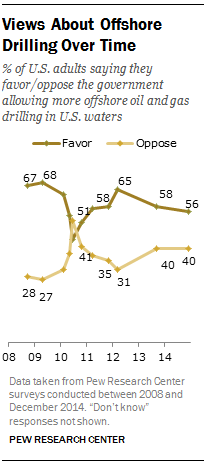
Other Pew Research surveys asked opinions about the government allowing more offshore oil and gas drilling in connection with “government policies to address America’s energy supply.”30 While this question is not directly comparable to that asked in the August 2014 Pew Research survey, the findings also show a majority of adults support more offshore oil drilling (56% favor, 40% oppose). Views on this question have fluctuated some over time, from a high in 2009 of 68% in favor of more offshore drilling, to a low in June 2010 of 44% in favor. Views about offshore oil drilling in this context have been steady in 2013 and 2014.
Gender, Age, Race and Ethnicity
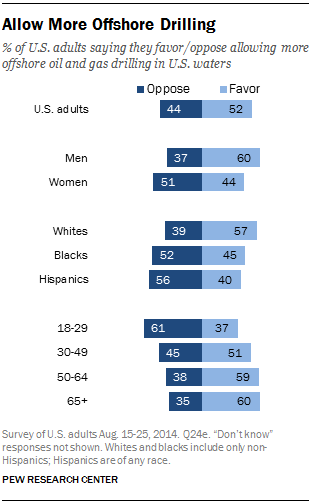
Opinion about allowing more offshore oil drilling differs by gender, race and ethnicity and age. Six-in-ten men favor allowing more offshore drilling, compared with 44% of women.
Younger adults, ages 18 to 29, stand out from other age groups for their higher levels of opposition to offshore oil drilling: 61% of adults under age 30 oppose drilling, while 37% favor more drilling. By contrast, six-in-ten adults ages 65 and older favor more drilling in U.S. waters for oil and gas; 35% are opposed.
Whites express more support for more offshore drilling than do either blacks or Hispanics. However, as noted below, differences among racial and ethnic groups about offshore oil drilling are largely explained by political differences among these groups.
Education and Knowledge
There are no statistically significant differences in views about offshore oil drilling among education or science knowledge groups.

Party and Ideology

Opinion about offshore oil and gas drilling differs strongly among party and ideological groups. Fully 72% of Republicans and leaning Republicans favor more offshore drilling, compared with 39% of Democrats and independents who lean Democratic.
Support for offshore drilling is especially low among political liberals, among whom 29% favor more offshore drilling, compared with 64% among conservatives and 57% among political moderates.
Opinion differences on allowing more offshore drilling are especially wide between conservative Republicans (87% favor and 13% oppose) and liberal Democrats (28% favor and 68% oppose).
Multivariate Analyses

A multivariate logistic analysis predicting support for more offshore drilling finds age and gender to be significant predictors of support, with older adults more so than younger adults (+0.30) and men more so than women (+0.15) in favor of allowing more drilling. In addition, both party affiliation and ideology significantly predict views on this issue. Republicans and leaning Republicans (+0.26) are more likely to favor more drilling than are Democrats and leaning Democrats. Conservatives (+0.22) and moderates (+0.23) are more likely to favor more drilling relative to liberals, while controlling for other factors. Specifically, conservative Republicans have a predicted probability of 0.76 and liberal Democrats have a predicted probability of 0.30 of favoring more offshore drilling, controlling for other factors.
A separate model (not shown) finds some significant differences among religious groups, even when controlling for these political and demographic factors. However, the factors described here remain significant predictors of support for offshore drilling even when religious affiliation and frequency of church attendance are controlled. (Details are available upon request.)
Hydraulic Fracturing

A minority of the public (41%) supports the increased use of hydraulic fracturing or “fracking” to extract oil and natural gas from underground rock formations, while 47% are opposed. Public support for fracking declined from 48% in support in March 2013 and has been stable in August and November of 2014.
An earlier Pew Research analysis found that opposition to increased fracking grew during this period, particularly among Midwesterners, women and those under age 50.31
Gender, Age, Race and Ethnicity
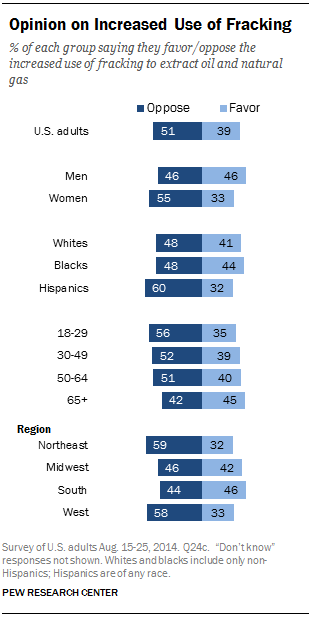
Men express more support than do women for the increased use of fracking (46% compared with 33%). Whites and blacks tend to support the increased use of fracking more than do Hispanics. And seniors, ages 65 and older, tend to express more support for fracking than do adults under age 30.
Note that these findings come from the August 2014 survey due to the availability of additional science knowledge and education variables. The patterns described here are roughly the same as those found in the Pew Research survey conducted a few months later in Nov. 2014.32
Education and Knowledge
Consistent with views about other energy issues, there are no differences (or only modest differences) by education on support for the increased use of fracking. Nor are there differences in views about fracking between those with more and less knowledge about science, generally.

Party and Ideology

There are wide differences of opinion among political party and ideological groups when it comes to fracking, as was also found on opinions about other energy issues. A majority of Republicans and independents who lean to the GOP express support for the increased use of fracking by a margin of 57%-33%. By contrast, a majority of Democrats and independents who lean to the Democratic Party oppose the increased use of fracking by a similar margin (62% oppose to 30% in favor).
Similarly, a majority of conservatives favor the increased use of fracking (54%) while seven-in-ten liberals oppose this idea.
Ideologically consistent party groups diverge strongly in their views about fracking. Fully 73% of conservative Republicans support the increased use of fracking, while 71% of liberal Democrats are opposed. Independents are split, with 35% in favor of the idea of increasing hydraulic fracturing and 57% opposed.
Multivariate Analyses

A multivariate logistic regression shows both party and ideological leanings significantly predict views about fracking. Republicans and those leaning to the GOP are more likely to support the increased use of fracking relative to Democrats and those leaning to the Democrats; the increase in predicted probability is 0.24. Conservatives (+0.24) and moderates (+0.15) are more likely to support the increased use of fracking than are liberals, all else being equal. Conservative Republicans/leaning Republicans are predicted to be 48 percentage points more likely to favor the increased use of fracking than are liberal Democrats/leaning Democrats, holding the other variables at their means.
Men are 12 percentage points more likely to support fracking than are women, with party and ideology statistically controlled. Blacks are 12 percentage points more likely to support fracking than are whites. There are no significant differences by education or science knowledge after controlling for other factors.
Building More Nuclear Power Plants

About half of Americans (51%) oppose building more nuclear power plants, while 45% are in favor. These figures are up modestly from 2009, when Pew Research last asked about this issue using the same question wording.
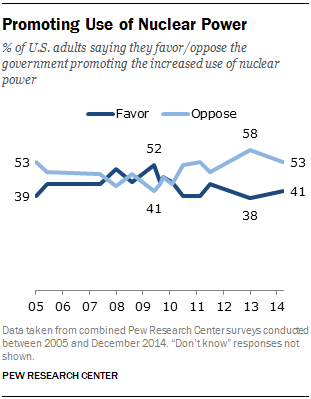
Other Pew Research surveys asked for opinions about the government promoting the use of nuclear power in connection with “government policies to address America’s energy supply.” 33 The December 2014 survey found 41% of adults in favor and 53% opposed to the government promoting the increased use of nuclear power. Views on this issue have fluctuated modestly in recent years.
Gender, Age, Race and Ethnicity
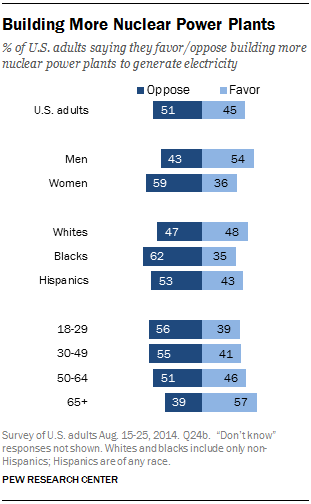
As with other energy issues, there are sizeable differences between men and women in views about nuclear power. A majority of men (54%) favor building more nuclear power plants while just 36% of women favor doing so. Older adults (ages 65 and older) are more inclined to favor building more nuclear power plants than are younger age cohorts. Blacks tend to express less support for nuclear power than do whites. Just 35% of blacks favor building more nuclear power plants, 65% oppose. By comparison, whites are closely divided on this issue, with 48% in favor and 47% opposed to building more nuclear power plants. Hispanics and non-Hispanic whites hold similar views on this issue. As noted below, however, race and ethnic differences are not significant once other factors are statistically controlled.
Education and Knowledge

There are some, though mostly modest, differences in views about nuclear power by education. Half of those with a college degree (and 54% of those also holding a postgraduate degree) favor building more nuclear power plants. By comparison, 43% of those with some college education and 42% of those with a high school degree or less favor building more nuclear power plants.
There are no significant differences between college-degree-holders with a background in science fields as compared to other fields on this issue. And, those with more and less general science knowledge hold similar views about nuclear power.
Party and Ideology
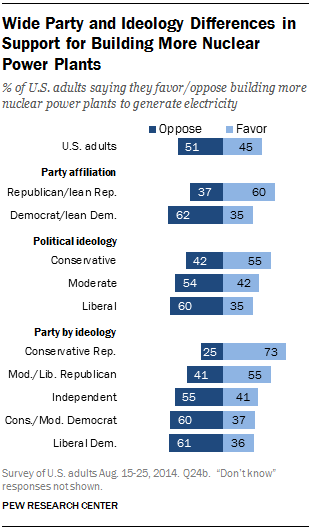
As with views about other energy issues, there are wide differences between party and ideological groups on views about nuclear power. A 60% majority of Republicans and independents who lean Republican favor building more nuclear power plants. By contrast, a similar share (62%) of Democrats and independents who lean to the Democratic Party oppose building more nuclear power plants.
Political conservatives are more likely than moderates or liberals to support building more nuclear power plants. Conservative Republicans express lopsided support for building more nuclear power plants by a margin of 73%-25%. A majority of moderate and liberal Republicans (55%) also support building more nuclear power plants. By contrast, a majority of political independents, conservative and moderate Democrats and liberal Democrats oppose building more nuclear power plants.
Multivariate Analyses
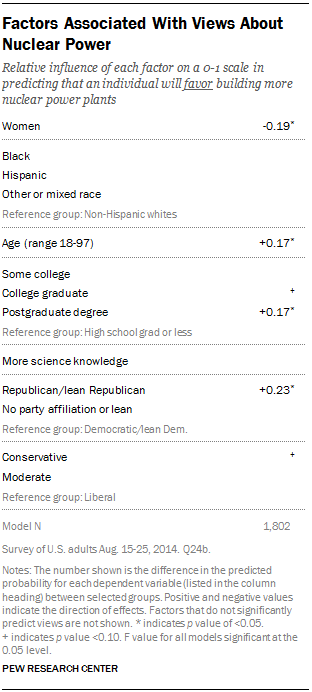
A multivariate logistic regression finds party identification a significant predictor of support for building more nuclear power plants. Those who identify with or lean to the GOP are 23 percentage points more likely to favor building more nuclear power plants, relative to their Democratic counterparts when holding all other factors at their means. The effect of ideology is weaker – being conservative does not quite reach statistical significance at the 0.05 level.
Those with a postgraduate degree are 17 percentage points more likely to favor building additional nuclear power plants. In contrast to several other science-related topics, education and political party influence attitudes about nuclear power in the same direction. In addition, men and older adults are more in favor of building more nuclear power plants. There are no statistically significant differences by race and ethnicity once other factors are statistically controlled.
A separate analysis, not shown, found no differences by religious affiliation or frequency of church attendance in views about nuclear power. (Details are available upon request.)
Prioritizing Alternative Energy Sources or Fossil Fuels

A separate Pew Research survey asked adults to choose between developing alternative energy sources and expanding the exploration and production of fossil fuels as the more important priority for addressing America’s energy supply. Overall, six-in-ten (60%) Americans said developing alternative energy sources such as wind, solar and hydrogen technology should be the priority, 30% said expanding the production of oil, coal and natural gas should be the priority.34
Gender, Age, Race and Ethnicity
Adults under 30 prioritize alternative energy development over expanding fossil fuels by a 74%-20% margin. By contrast, those ages 65 and older are more divided with 48% giving priority to developing alternative energy sources such as wind, solar and hydrogen technology and 41% saying that expansion of oil, coal and natural gas should be the priority.
Women are a bit more likely than men to prioritize the development of alternative energy sources. Differences among race and ethnic groups are not statistically significant.
Education

On average, those with a postgraduate degree tend to prioritize the development of alternative energy sources (69%) over expansion of fossil fuel production (24%). Support for prioritizing alternative energy development over expanding fossil fuel production is lower among those with no more than a high school diploma (55%-33%).
While the index of science knowledge was not asked on this survey, one question captured an issue tied to specific knowledge about energy issues. Overall 54% of adults were aware that the amount of energy produced in the United States has been increasing “in recent years.” Knowing that America’s energy production has been on the rise is not significantly related to views about priorities for energy supply, however.
Party and Ideology

There are wide differences in energy priorities along party and ideological lines.
Democrats and independents who lean to the Democratic Party express broad support for prioritizing alternative energy production (75%-17%). Liberal Democrats also express strong support for prioritizing alternative energy sources over expanding traditional fossil fuel sources (81%-15%).
Overall, Republicans and those who lean to the GOP are more closely divided (46%-43%). Differences among this group are largely due to sizeable differences between independents, a majority of whom prioritize development of alternative energy sources, and those who identify with the GOP (only 36% of whom prioritize alternative energy development).
Multivariate Analyses
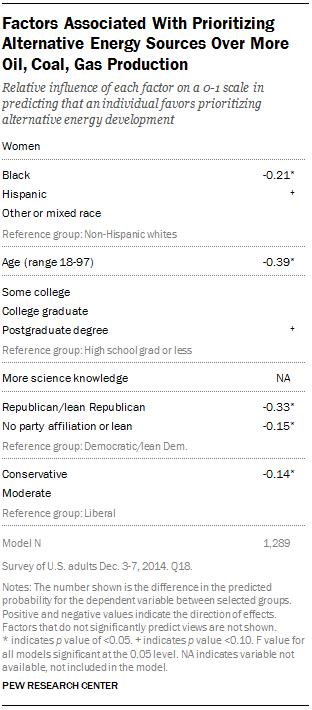
A multivariate logistic regression analysis finds a strong effect of party identification on energy policy priorities. Republicans and leaning Republicans are 33% less likely than their Democratic counterparts to prioritize developing alternative energy sources over expanding oil, coal and natural gas production. Those with no party affiliation or leaning are less likely than Democrats and independents who lean to the Democratic Party to hold this position (-0.15). And, conservatives are 14% less likely than liberals to prioritize alternative energy development. The predicted probability for a liberal Democrat (or independent leaning Democratic) to prioritize alternative energy development is 0.86, while the predicted probability for conservative Republicans (or independents leaning to the GOP) is 0.41 – a difference of 45 percentage points, controlling for other factors.
In addition, there are strong differences by age with older adults 39% less likely than younger ones to say that development of alternative energy sources should be a more important priority than expansion of fossil fuel production. Blacks are less likely than whites to say the same (-0.21), controlling for other factors.
Genetically Engineered Fuel from Plants
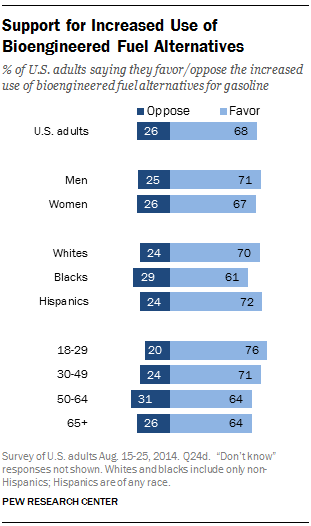
Fully 68% of adults favor one newer form of energy development — increased use of genetically engineered plants as a fuel alternative to gasoline. Just 26% of adults oppose the increase use of genetically engineered plants as an alternative to gasoline.
Gender, Age, Race and Ethnicity
There are few differences among subgroups of the population on this topic, perhaps reflecting limited public familiarity with this new form of energy technology. Both men and women hold about the same views when it comes to bioengineered fuel alternatives from plants. African Americans are less likely than either whites or Hispanics to express support for increased use of genetically engineered plants as a fuel alternative to gasoline. And older adults express less support for this idea than do younger adults.

Education and Knowledge
There are no differences in views about bioengineered plant-based fuel alternatives by education or knowledge levels about science facts.
Party and Ideology
Unlike other energy technologies, there are no differences in views about genetically engineered fuel alternatives by party or ideology.
Multivariate Analysis
We tested a model predicting support for the increased use of bioengineered fuel but found the model was not significant in predicting views on this issue.35
Population Growth and Natural Resources

A majority of Americans express concern that world population growth will strain the planet’s natural resources: 59% of adults have a pessimistic view about the effect of population growth, saying it will be a major problem because there will not be enough food and resources to go around. Nearly four-in-ten (38%) take the view that growth will not be a major problem because the world will find a way to stretch its natural resources. Views on this issue are roughly the same as when Pew Research last asked about them in a survey in 2013.
Gender, Age, Race and Ethnicity
African Americans are more optimistic that new solutions will emerge to address the strains on natural resources caused by a growing world population. Whites and Hispanics, by comparison, are more likely to see the growing world population as leading to a major problem. Sizeable opinion differences by race and ethnicity were also present in the 2013 survey.
There are no differences or only modest differences in viewpoints about this issue by gender or age.

Education and Knowledge
There are no differences in views about this issue across education groups. A majority of all education groups say that the growing world population will be a major problem because there won’t be enough food and resources to go around. And, those with more and less knowledge about science hold roughly the same views about this issue.
Party and Ideology

Republicans and leaning Republicans are more inclined than are Democrats and those leaning to the Democratic Party to believe that the growing world population will not pose a major problem because we will find a way to stretch our natural resources. Political conservatives, of any party affiliation, are divided between this point of view (48%) and the view that growth in the world population will pose major problems on food supplies and natural resources (49%).
A 54% majority of conservative Republicans believe we will find a way to stretch our natural resources, while 44% say that growing world population will be a major problem. By contrast, fully 69% of liberal Democrats say the global population growth will pose major problems on our food supply and natural resources and just three-in-ten say we will find a way to stretch resources such that global population growth will not be a major problem.
Multivariate Analyses

A multivariate logistic analysis finds that both party affiliation and political ideology predict views about resources and population growth. As shown above, conservatives are more likely than liberals to say that global population growth will not pose a major problem because we will find a way to stretch resources. Conservatives are 18 percentage points less likely than liberals to hold this view, holding all other factors at their means. Republicans and those who lean to the GOP are more inclined than Democrats and independents that lean to the Democratic Party to say that global population growth will not be a major problem because we will find a way to stretch resources.
African Americans are less likely to say the growing world population will be a major problem than are whites. The change in the predicted probability of a black respondent saying the growth in the global population will be a major problem is 27 percentage points as compared with a white respondent, when all other factors are statistically controlled.
A separate analysis finds religious groups to significantly predict views on this issue but the factors described above are statistically significant even with religious affiliation and frequency of church attendance controlled. (See forthcoming report on religion and science-related attitudes; model details are available upon request.)




